If you’re looking to include tiger barbs in your aquarium, you may be hesitant of their reputation as a semi-aggressive fish.
But, have no fear, tiger barbs don’t need to be kept in isolation. There are plenty of potential tank mates to choose from that’ll get along just fine with your tiger barb. Find the right ones to suit your aquarium below.
1. Cherry barb (Puntius titteya)
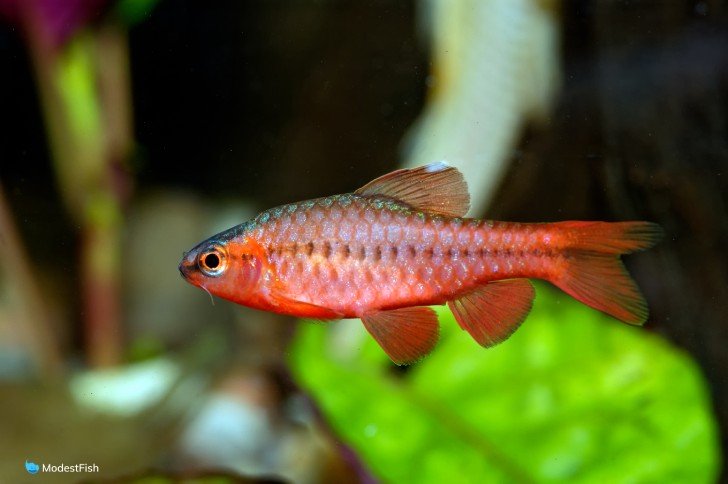
- Care Level: Easy; great fish for beginners.
- Temperament: Peaceful.
- Size: 2 inches.
- Min Tank Size: 25 gallons.
- Diet: They will eat mostly fish flakes, occasionally supplemented with bloodworms or brine shrimp.
Cherry barbs are a popular aquarium fish due to their striking colour. They stand out in an aquarium and are really energetic fish. Best of all, they are super easy to care for.
They are relatively shy and won’t bother their other tank mates, but they do like to be kept in schools. You will need to keep them in a group of six or more of their own kind for them to thrive.
They make the perfect tank mates for tiger barbs as both have the same requirements in terms of tank size. In addition, their temperature range is 73 to 79℉, which would be the ideal temperature for your tiger barbs.
2. Rosy barb (Pethia conchonius)
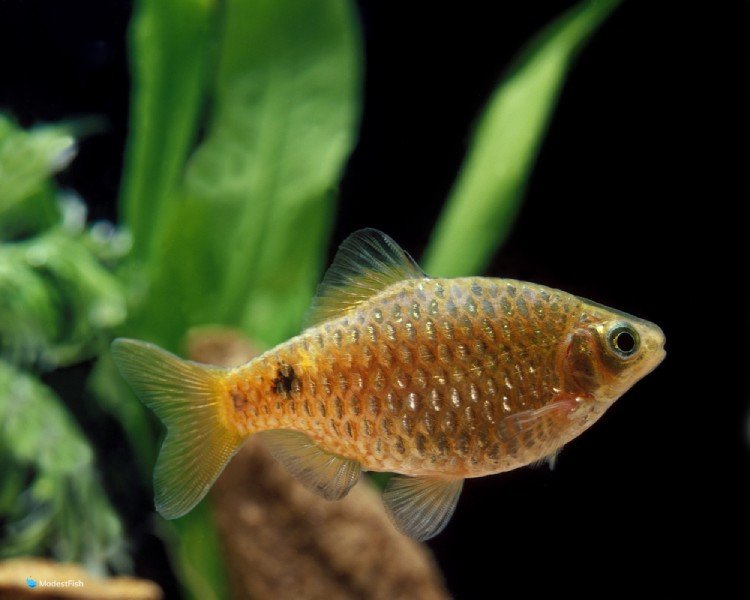
- Care Level: Easy.
- Temperament: Peaceful, so long as they have some companions of their own species.
- Size: 6 inches.
- Min Tank Size: 30 gallons.
- Diet: They require a varied diet of pellets, flakes, and small live foods like daphnia and brine shrimp. As a special treat, they can also be given peas or zucchini.
Rosy barbs are one of the larger barb species but they make a great addition to community tanks. Their colour can range from pale yellow to bright red and they are a great looking fish.
They are a schooling fish and will do a lot better in a group of at least six. They are much more active when kept in a school, and they will be more peaceful as well, which makes for better fish watching.
They are a very energetic fish and can really liven up your tank. But they are excellent jumpers so you will need a tank with a secure lid to prevent them from jumping out.
Other barb species, including rosy barbs, make great tank mates for tiger barbs, as they can hold their own against any nipping behaviour and stand up for themselves.
3. Tinfoil barb
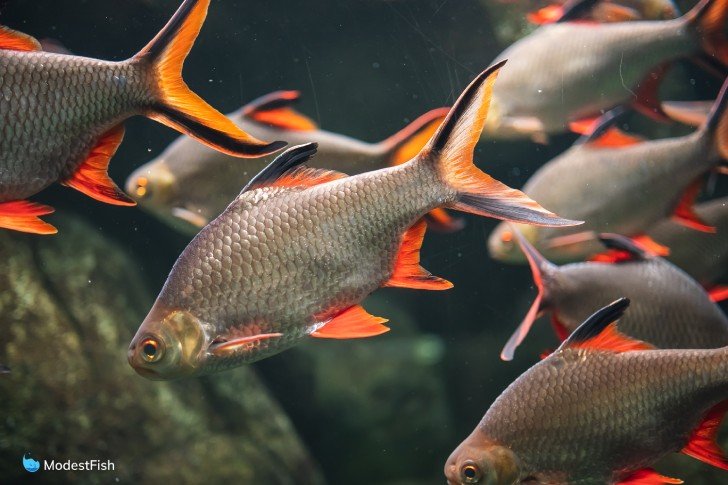
- Care Level: Moderate.
- Temperament: Non-aggressive to fish of roughly the same size, but may eat smaller tank mates.
- Size: Can reach up to 14 inches.
- Min Tank Size: 75 gallons.
- Diet: They eat a varied diet of flakes or pellets, along with plants, live foods, and frozen foods.
As their name suggests, tinfoil barbs are a shiny silver colour and they are a really eye-catching addition to an aquarium. They make a great conversation starter as they’re sure to have many admirers.
Like most barbs, they are a schooling fish and should be kept in groups of six or more. But they are large fish and are active swimmers, which can be a challenge for some fish keepers as it means they need a fairly large tank.
They do, however, make good tank mates for tiger barbs. They have a similar temperature range and, like other barbs, they can handle a little nipping.
4. Red-tailed shark (Epalzeorhynchos bicolor)

- Care Level: Easy
- Temperament: Semi-aggressive; should not be kept with small fish.
- Size: 5 inches.
- Min Tank Size: 50 gallons.
- Diet: They are scavengers and will eat a diverse diet of flakes, pellets, algae, live food, and frozen food.
Red-tailed sharks need a large tank with plenty of plants, rocks, and caves for them to hide amongst. They will also need a tight-fitting lid as they are good jumpers. Nevertheless, as active swimmers, they can really liven up your aquarium.
Since they are scavengers, they will also take care of any leftovers that might otherwise dirty up your tank. They will even occasionally feed on excess algae, helping to keep the tank clean.
They should not be kept with fish much smaller than themselves, however, as they may become aggressive towards them. They are also aggressive to their own kind and so should only be kept as individuals. They will happily live alongside tiger barbs, though.
5. Corydora (Corydoras)
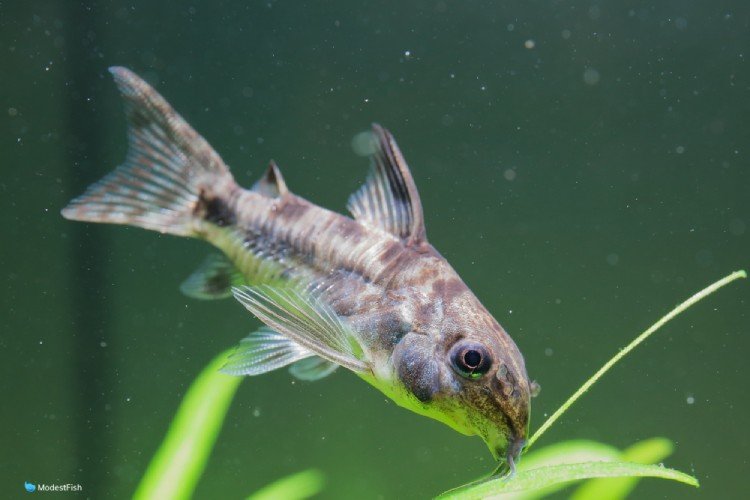
- Care Level: Easy.
- Temperament: Peaceful.
- Size: 2.5 inches.
- Min Tank Size: 20 gallons.
- Diet: They are algae eaters, but can also be fed pellets and flakes.
Corydoras are bottom dwellers so they are unlikely to interact with your tiger barbs much. They will, however, keep your tank clean as they are great little algae eaters.
They are very social fish and will need to be kept in small groups. They also need a lot of hiding places and at least 2 inches of substrate in their tank. They are a very calm fish, though, and would be a great addition to a community tank.
They prefer cooler waters but are capable of tolerating a range of temperatures, including the lower end of the tiger barb’s range.
There are several different species of this freshwater catfish, with different colours and patterns to choose from, so you’re sure to find one that appeals to you.
6. Pleco (Hypostomus plecostomus)
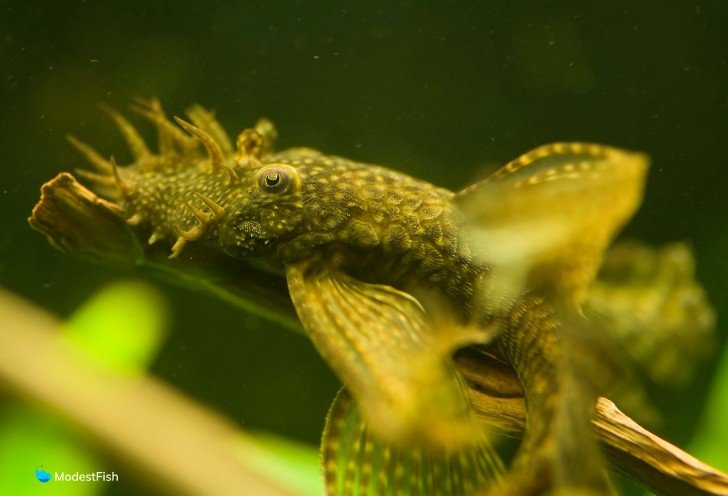
- Care Level: Moderate.
- Temperament: Peaceful.
- Size: Varies with species, 4 to 18 inches.
- Min Tank Size: Varies with species, usually over 100 gallons.
- Diet: They are algae eaters and will eat algae wafers to supplement, as well as cucumber as an occasional treat.
Plecos are an interesting looking fish and there are several different species for a hobbyist to choose from. They are a type of catfish and have armour plates instead of scales. They are bottom-feeders and are great for removing any excess algae.
They are solitary fish and should not be kept with other plecos since, while they are generally peaceful, they can become aggressive towards their own kind.
You do need to be careful about which species you choose for your tank as some can grow quite large. A clown pleco would be the best fit for a tank with tiger barbs as they only grow to 4 inches and won’t need as big a tank as the larger species.
7. Molly Fish (Poecilia sphenops)
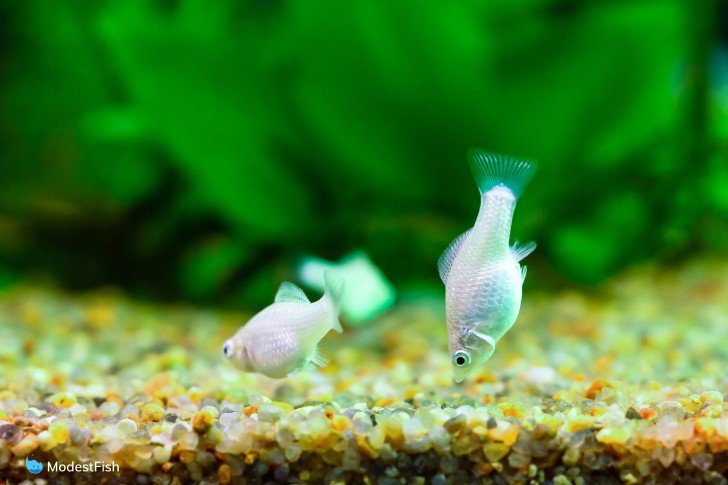
- Care Level: Easy.
- Temperament: Very docile and rarely aggressive.
- Size: Usually 3 to 4 inches, 6 inches max.
- Min Tank Size: 25 gallons.
- Diet: They are omnivores and will eat a variety of flakes, pellets, plants, and live or frozen foods.
Mollies are very popular and are one of the easiest aquarium fish to care for. And there are so many varieties to choose from with different colours, patterns, and tail shapes.
They do best in groups with one male and three or four females. Unlike most other fish, they are livebearers and will reproduce quite easily, so you could end up with a lot of little ones in your tank. However, they also produce a lot of waste, so excellent filtration is a must.
They generally get along well with tiger barbs, though it’s best to stay clear of the long-tailed varieties to avoid nipping.
8. Platy fish
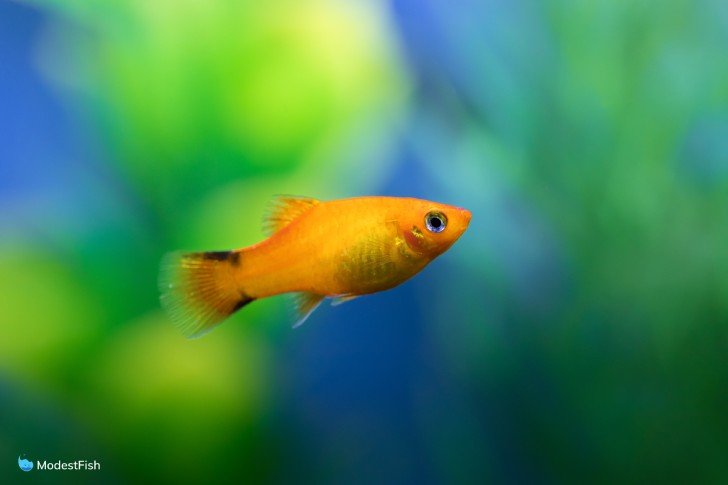
- Care Level: Easy.
- Temperament: Very peaceful.
- Size: 2 to 3 inches.
- Min Tank Size: 10 gallons.
- Diet: They can eat a variety of foods, including pellets, live foods, frozen foods, and flakes.
Platies are very brightly colored fish with lots of varieties to choose from. There’s even the Mickey Mouse platy that has distinct markings in the shape of the classic Mickey Mouse logo.
They are another livebearer and will breed readily. They should be kept in groups with a ratio of one male to two females, otherwise the males may fight among themselves.
They can tolerate a wide range of temperatures from 65 to 78℉ and they don’t stress easily. This makes them a great tank mate for tiger barbs. Though, when keeping them together, you will need to keep an eye out for occasional nipping from both parties.
9. Swordtail
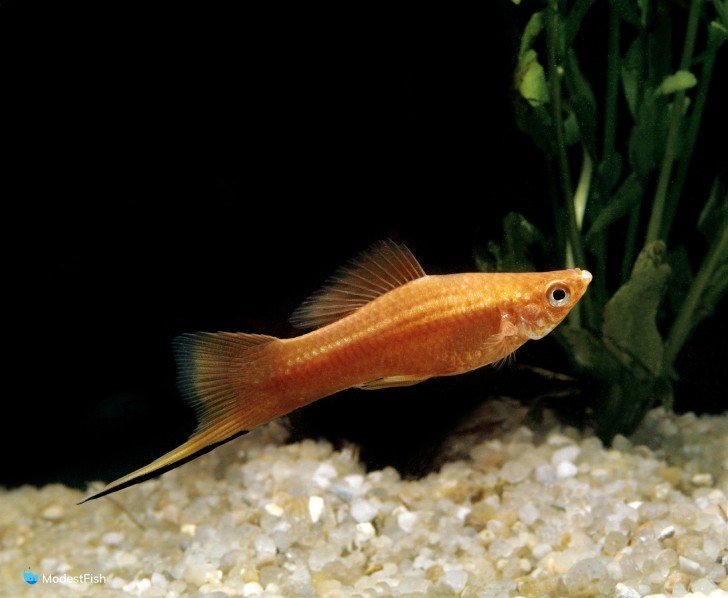
- Care Level: Very easy.
- Temperament: Peaceful.
- Size: 4 to 5 inches.
- Min Tank Size: 10 gallons.
- Diet: They will eat a varied diet of flakes, and frozen or live foods, with some occasional greens.
Swordtails are a really popular aquarium fish, especially for beginners. They are very hardy and not particularly sensitive to changes in the water, which makes them relatively easy to care for. They are a very attractive fish and come in a variety of colours and patterns. The male’s unusual looking tail is especially eye-catching.
Like mollies and platies, they are livebearers and, if you keep a male and females together, you are likely to end up with lots of fry. They are generally a peaceful community fish, but males should not be kept together.
They have similar water and feeding requirements as tiger barbs, making them a good tank mate. It is important to watch out for nipping from both fish, however.
10. Black Widow Tetra
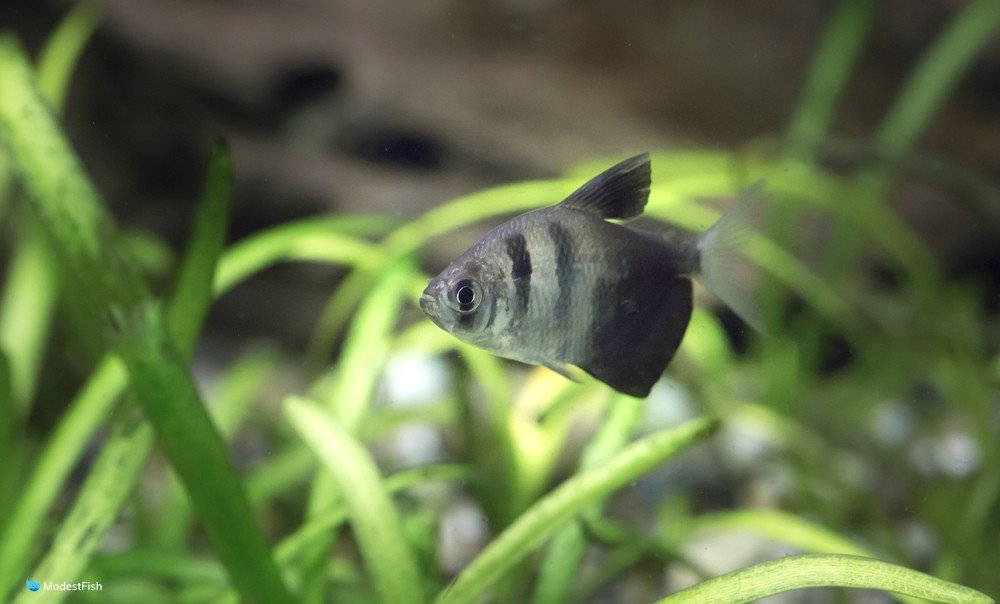
- Care Level: Easy.
- Temperament: Peaceful, good community fish.
- Size: 2 inches.
- Min Tank Size: 15 gallons.
- Diet: They should be fed a varied diet of flakes, brine shrimp, bloodworm, and vegetation.
Black widow tetras (also known as black skirt tetras) are a hardy fish that are able to adapt to a range of conditions. Their vibrant, black markings really help them stand out and they will fit in well in a community tank.
They are schooling fish and should be kept in groups of 6 or more. Though they are generally peaceful, they will occasionally nip on long, flowing fins, so they should not be kept with bettas or angelfish. They also shouldn’t be kept with really small tank mates, but they will get along great with your tiger barbs.
Like tiger barbs, they prefer a well-planted aquarium. In addition, their preferred temperature range is a good match for that of a tiger barb at 68 to 79℉. And both fish can cope with the other’s nipping.
What Makes an Ideal Tank Mate?
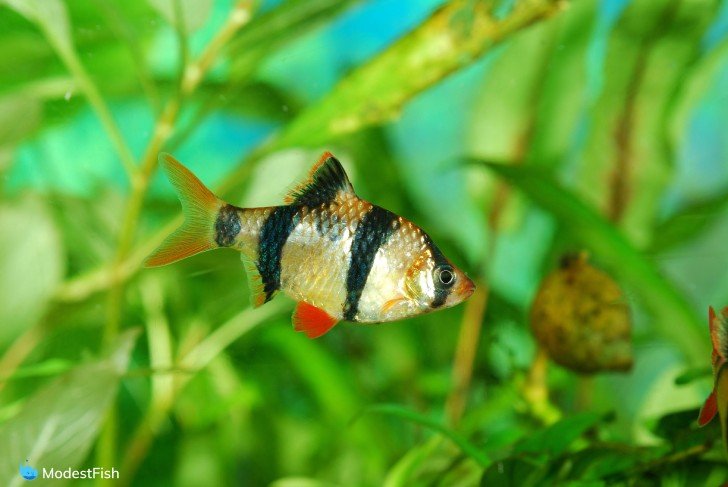
Tiger barbs are relatively easy to keep but not all fish will get along with them. One of the main issues is that they can become aggressive. They need to be kept in groups of at least six or they are likely to start nipping at their tank mates. Even with a school of fellow tiger barbs to keep them distracted, you must take some time to consider the ideal tank mate.
They should be housed with fish of a similar size or larger since smaller fish might not be able to handle any bullying from your tiger barbs. In addition, you should avoid fish with long fins as this will only encourage nipping behaviour. They also shouldn’t be kept with aggressive fish as this may escalate things, but they are generally okay with peaceful community fish.
When choosing tank mates for your tiger barbs, the size of your tank is also an important consideration. For example, if you have a tank of 20 gallons, the minimum size needed to house tiger barbs, you may not have the space for other schooling fish and solitary tank mates may be best. It’s generally a good idea to pick tank mates with similar needs in terms of their required space.
In fact, the ideal tank mate for a tiger barb will have similar needs in general. Tiger barbs are tropical fish and like water temperatures within the range of 70 to 78℉. They like a well-planted aquarium and are active swimmers, so need a lot of open space to move around. It’s important to find tank mates that will also be happy in such an environment.
Which is Right for You?
With plenty of fish to choose from when looking for tank mates for your tiger barbs, deciding which is right for you will depend on your tank. Things you will need to consider before choosing include the size of your tank, the needs of the fish already in the tank, and whether the tank mates are solitary or schooling fish.
With these in mind, you can find the ideal tank mate for your tiger barbs.
